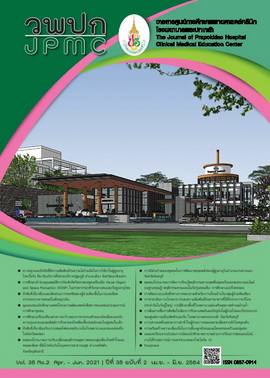The Effects of A Safe Sex Behaviors & Chatting Program Based on The Theory of Planned Behavior among Early Adolescents: A Quasi-experimental Study
Main Article Content
Abstract
BACKGROUND: Development of an intervention program based on the theory of planned behavior is needed for health protection and mitigation of health risks for early adolescents
OBJECTIVES: This study aimed to examine the effects of a safe sex behaviors and chatting program based on the theory of planned behaviors, including positive attitudes towards safe-sex behaviors, peer norms, perceived behavioral controls, and intention to practice safe-sex behaviors in experiment and control groups.
METHODS: This research model utilizes quasi-experimental research. The participants were 64 secondary school students in Bangkok, Thailand who were randomly assigned to participate in the research. The control group totaled 32 individuals, and sexuality education was managed according to the standard education lessons from school teachers. The experiment group, which also totaled 32 individuals, participated in
a program based on attitude-building, perceived behavioral control, and peer willingness to practice safe-sex that was designed to encourage safe-sex behaviors and online chatting containing sexual content. The data collection tool was a questionnaire which was completed by participants three times: once before the trial, once immediately following the end of the trial, and a final time one month later. The data were analyzed by Mann Whitney U Test and Friedman Test (repeated measure).
CONCLUSIONS: The Safe Sex Behaviors and Chatting program resulted in increased perceived behavioral control immediately after the experiment and one month after its conclusion.
Article Details
References
United Nations Children’s Fund. The adolescent brain: a second window of opportunity [Internet]. Florence, Italy; 2017 [cited 2020Nov]. Available from: https://www.unicef-irc.org/publications/pdf/adolescent_brain_a_second_window_of_opportunity_a_compendium.pdf
Muanphetch C, Maharachapong N. Social media usage behavior and sexual intercourse among Thai adolescents. J Prapokklao Hosp Clin Med Educat Center. 2020;37:232-39.
Ministry of Public Health. Department of Health. Reproductive health situation in adolescents and youths in 2019 [Internet]. 2020 [cited 2020 Nov]. Available from: https://rhold.anamai.moph.go.th/download/all_file/index/สถานการณ์RH_2562_Website.pdf
Monyarit S. Situation of the 5 main sexually transmitted diseases in youth in Thailand, fiscal year 2014-2018 [Internet]. 2020 [cited 2020 Nov 2]. Available from: https://ddc.moph.go.th/uploads/publish/1006020200507053840.pdf
Icek A. The theory of planned behavior [Internet]. 1991 [cited 2020 Nov 5]. Available from: https://www.researchgate.net/figure/Theory-of-Planned-Behaviour-Ajzen-1991_fig1_5407720
Duangmahasorn S, Srisuriyawet R, Homsin P. Effect of positive development program on attitudes toward premarital sex perceived self-efficacy, and Intention to refuse premarital sex among early adolescents. Journal of Nursing and Education 2015 ;8(1):85-98.
Doubova SV, Martinez-Vega IP, Infante-Castañeda C, Pérez-Cuevas R. Effects of an internet-based educational intervention to prevent high-risk sexual behavior in Mexican adolescents. Health Educ Res 2017;32:487-98.
Teanchaithut C, Masingboon K, Wacharasin C. A causal model of safe sex behaviors in female adolescents. Journal of Phrapokklao Nursing College 2016; 27(2):78-94.
Kumalaningrum M, Pamungkasari EP. Nurhaeni IDA. Multilevel analysis on the predictors of safe sexual behavior among girl adolescents in Karanganyar. Journal of Health Promotion and Behavior [Internet]. 2017[cited 2021 Jan 16]; 2(4): 323-31. Available from: https://doi.org/10.26911/thejhpb.2017.02.04.04
Bingenheimer JB, Asante E, Ahiadeke Clement. Peer influences on sexual activity among adolescents in Ghana. Stud Fam Plann [Internet]. 2015 [cited 2021 Jan 16]; 46(1):1–19. Available from: https://www.ncbi.nlm.nih.gov/pmc/articles/PMC4391617/pdf/nihms666222.pdf
Teye-Kwadjo E, Kageeb A. Swartb H. Determinants of condom use among heterosexual young men and women in southeastern Ghana: a mediation analysis. J Psychol Hum Sex [Internet]. 2017 [cited 2021 Jan16]; 8:291–305. Available from: https://doi.org/10.1080/19419899.2017.1391870
Morales A, Vallejo-Medina P, Abello-Luque D, Saavedra-Roa A, García-Roncallo P, Gomez-Lugo M, et al. Sexual risk among Colombian adolescents: knowledge, attitudes, normative beliefs, perceived control, intention, and sexual behavior. BMC Public Health [Internet]. 2018 [cited 2020 Oct 24];18:1377. Available form: https://bmcpublichealth.biomedcentral.com/articles/10.1186/s12889-018-6311-y
Polit DF, Hungler BP. Nursing research: principles and methods . 6thed. Philadelphia: J.B. Lippincott; 1999. 794 p.
Tungsaengsakul S, Suwonnaroop N, Nakakasien P, Panitrat R. Effects of sexual health Life skills program on perceived self- efficacy in safe sex of early adolescent students. Journal of The Royal Thai Army Nurses 2017;18(2):119-28.
Kingmala C, Rawiworrakul T, Powwattana A. Effect of a pregnancy prevention program for female adolescence. Journal of Boromarajanani College of Nursing , Bangkok. 2015;31(3):25-34.
Unis BD, Sällström C. Adolescents’ conceptions of learning and education about sex and relationships. Am J Sex Educ [Internet]. 2020. [cited 2021 Jan16];15(1):25-52. Available from : https://doi.org/10.1080/15546128.2019.1617816
Chiengta P, Tumchea S, Maneechot M, Lorhhana S, Pumprayool P, Yingrengreung S. Effect of a sexual health promotion program on pregnancy prevention of teenage in Saraburi Municipal. Journal of Boromarajanani College of Nursing , Bangkok. 2018; 34 (2):101-11

